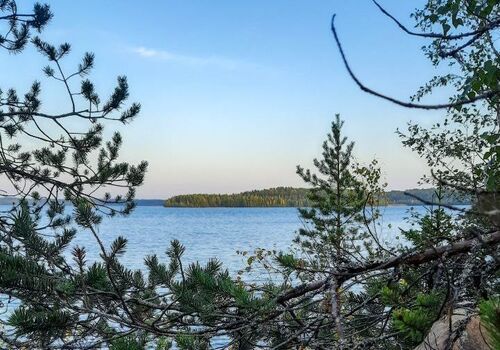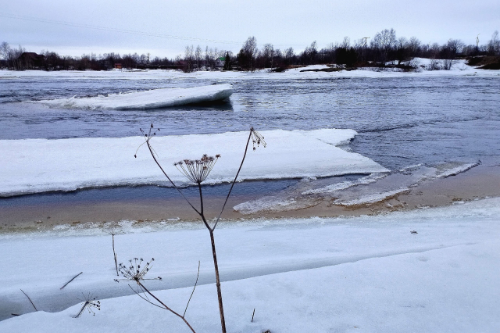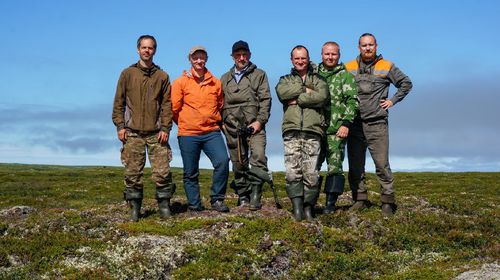An integrated expedition of scientists from KarRC RAS to the White Sea Tersky Coast ended on July 15th. It was a continuation of the study of this arctic territory which started last year.
Being difficult to access, the northern part of the Tersky Coast is rather poorly studied. Research vessels in possession of KarRC RAS enable the Center’s scientists to reach such territories and survey them. The White Sea expedition was based on board the Ekolog research vessel.
The team split into several groups for most of the fieldwork. One of the focus areas was the study of permafrost-underlain palsa bogs. Their thawing is monitored as a marker of climate change. Palsa bogs were studied by Senior Researcher at the Department for Multidisciplinary Research (DMR) KarRC RAS Pavel Ryazantsev, Head of the Mire Ecosystems Laboratory of the Institute of Biology KarRC RAS Stanislav Kutenkov, Junior Researcher at the Laboratory for Ecological Monitoring and Modeling DMR KarRC RAS Yulia Tkachenko, and Doctoral Student at the Petrozavodsk State University Aleksey Kabonen.
Researchers from the Laboratory for Ecological Monitoring and Modeling DMR KarRC RAS Nikolai Petrov and Boris Raevsky continued working on the set of field keys, which are necessary for mapping modern vegetation using satellite images as the basis.
Species identification and monitoring were the tasks for botany expert, Senior Researcher at the DMR KarRC RAS Think Tank Aleksey Kravchenko and entomologist, Leading Researcher at the Laboratory for Landscape Ecology and Forest Ecosystem Protection of the Forest Research Institute KarRC RAS Andrey Humala. Senior Researcher at the Laboratory for Precambrian Geology and Geodynamics of the Institute of Geology KarRC RAS Pavel Medvedev studied rock species of the northern Kola Peninsula.
– All expedition participants have managed to accomplish the planned activities and tasks. The collected data will now be treated and analyzed. They will soon be presented in our reports and scientific papers, – remarked the expedition leader, DMR KarRC RAS Secretary for Science Nikolai Petrov.
The expedition was organized by the Department for Multidisciplinary Research (DMR) KarRC RAS. More details on the results and activities of its participants will be published in further posts on our website.
Photo by the expedition leader Nikolai Petrov
News
See also:

July 7, 2025
A successful introduction: the zander has settled down in Lake Sundozero and continues to spread
Scientists of the Institute of Biology KarRC RAS have published the results of long-term observations over the population of the zander (or pikeperch) introduced to Lake Sundozero more than a half-century ago. They confirm the species has become naturalized. Maintaining the population requires regulation of harvesting, protection during spawning, and tending of spawning grounds.
Scientists of the Institute of Biology KarRC RAS have published the results of long-term observations over the population of the zander (or pikeperch) introduced to Lake Sundozero more than a half-century ago. They confirm the species has become naturalized. Maintaining the population requires regulation of harvesting, protection during spawning, and tending of spawning grounds.

June 26, 2025
Ice-related phenomena on rivers emptying into the White Sea now last three weeks less than 60 years before
Ice on northern rivers now forms later while ice-off occurs earlier. Karelian scientists confirmed this having analyzed 64 years of marine and meteorological data from the estuaries of rivers draining into the White Sea along its western coast. Climate change has bit three weeks off the ice-covered period on these rivers. The reductions have been the most significant in the last 30 years, aligning with global warming trends in Arctic water bodies.
Ice on northern rivers now forms later while ice-off occurs earlier. Karelian scientists confirmed this having analyzed 64 years of marine and meteorological data from the estuaries of rivers draining into the White Sea along its western coast. Climate change has bit three weeks off the ice-covered period on these rivers. The reductions have been the most significant in the last 30 years, aligning with global warming trends in Arctic water bodies.

June 23, 2025
Citizen science and web technologies help researchers study insects of Karelia
More than 30 insect species not encountered in Karelia previously have been revealed by entomologists from KarRC RAS during their expeditions and using data communicated by active participants of the iNaturalist portal – an open platform for collecting biodiversity data.
More than 30 insect species not encountered in Karelia previously have been revealed by entomologists from KarRC RAS during their expeditions and using data communicated by active participants of the iNaturalist portal – an open platform for collecting biodiversity data.




